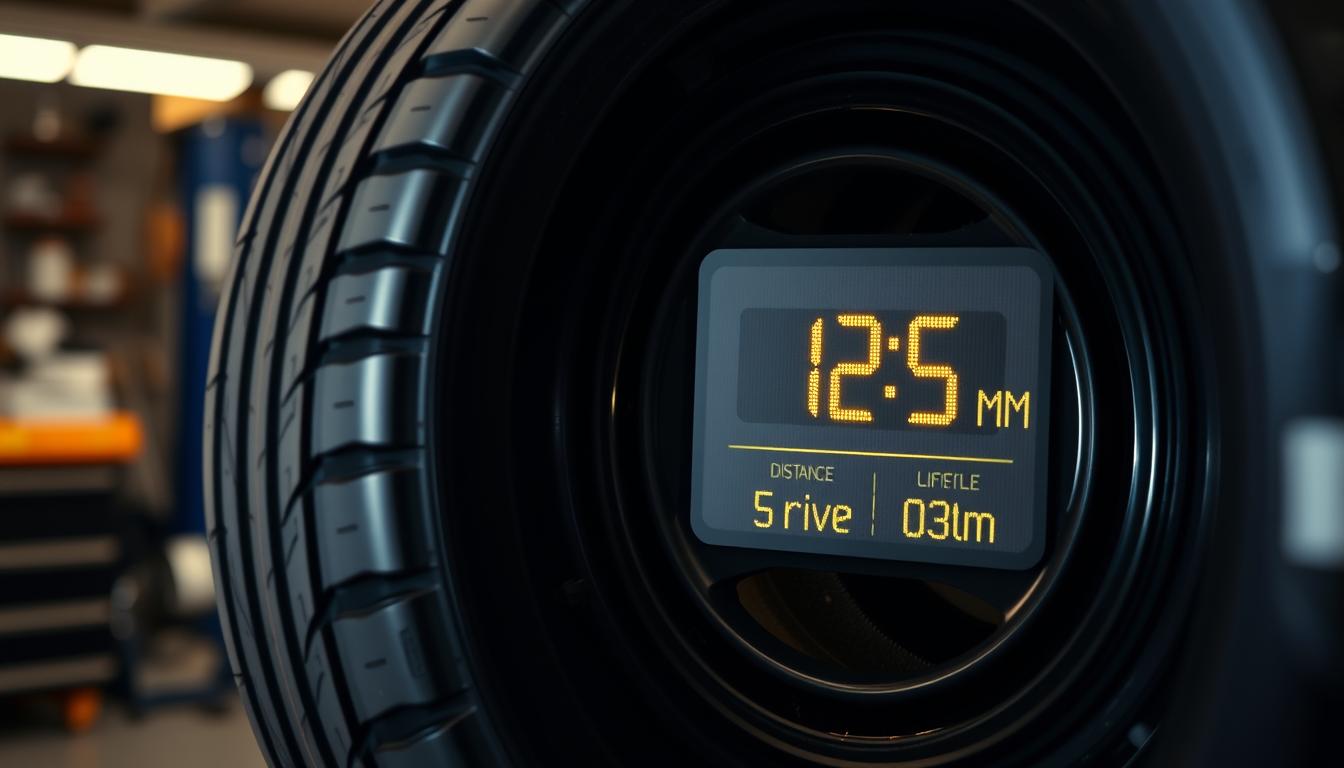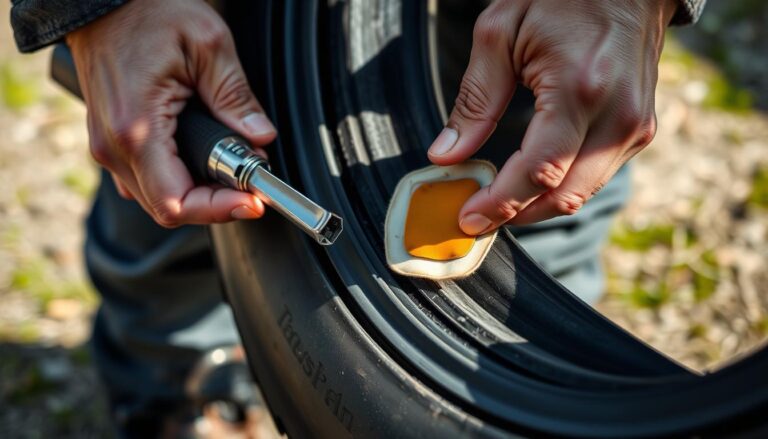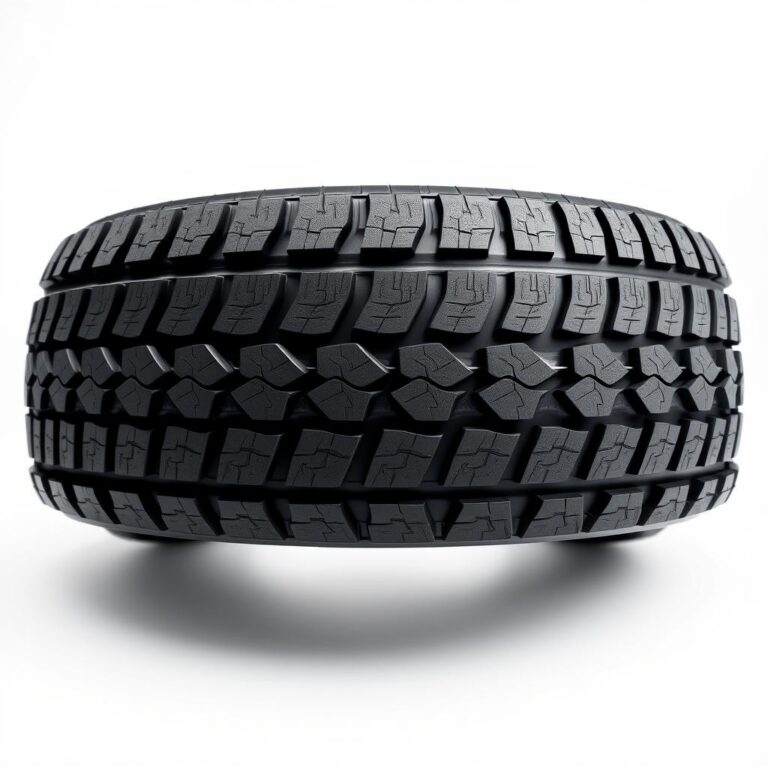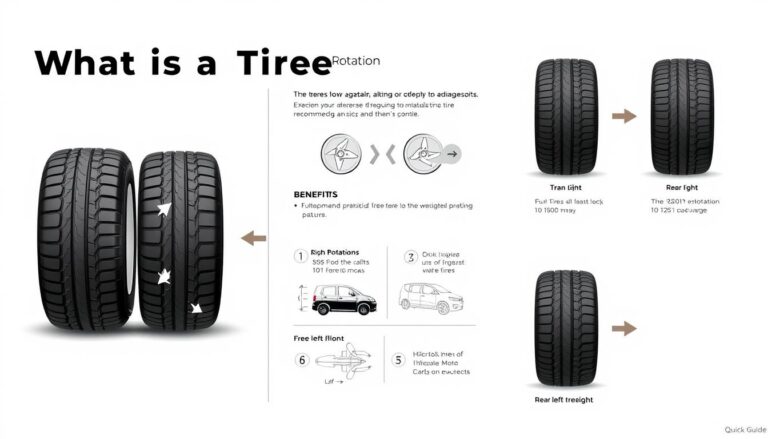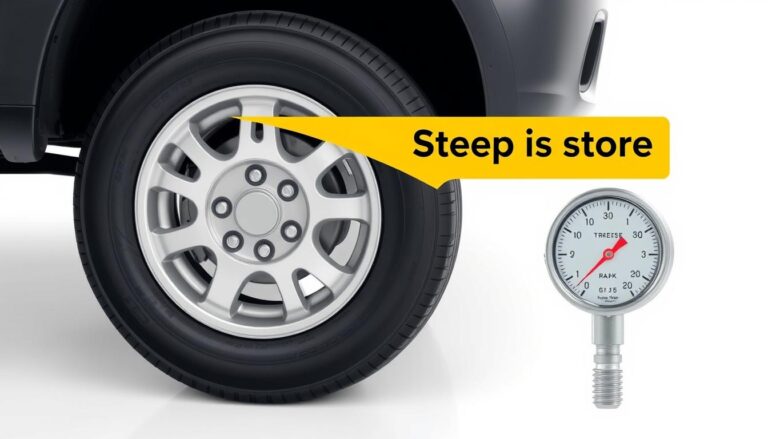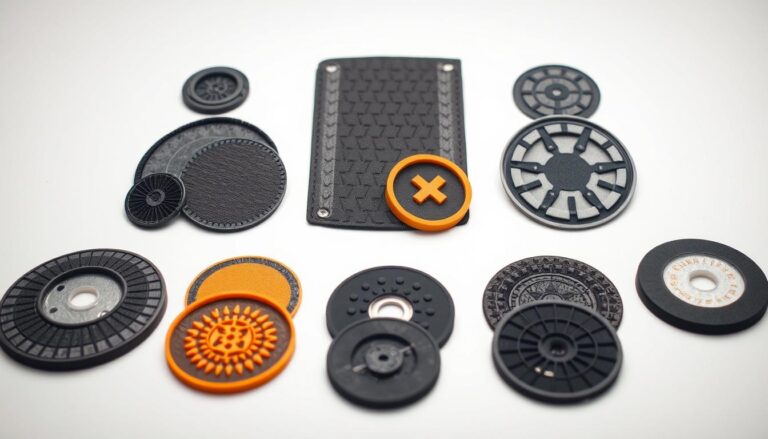Spare Tire Lifespan: How Far Can You Go?
Drivers facing a flat tire know how vital a good spare is. Knowing how long you can drive on a spare is a key safety skill. The lifespan of a spare tire depends on many factors, so it’s important to know its limits.
Experts say strict rules for driving on a spare tire are key to avoid damage. Temporary spares are not for long trips or high speeds. They’re for short distances to get to a repair shop safely.
Car makers give clear advice on using spares. Most say use them for 50-70 miles and under 50 mph. Treat them as temporary fixes and get a new tire as soon as you can.
Knowing your car’s spare tire rules can avoid trouble on the road. This guide will cover spare tire types, use, safety, and tips for tire emergencies.
Understanding the Basics of Spare Tires
Spare tires are key safety items in today’s cars. They offer backup protection when a tire fails. Knowing about spare tire duration and usage rules helps drivers prepare for emergencies.
Car makers have created many spare tire designs. These meet different driving needs. The main types are:
- Full-size spare tires: The same as regular wheels
- Compact temporary spares: Light emergency options
- Run-flat tire systems
- Tire repair kits
Different Types of Spare Tires Explained
Each spare tire type has its own features and rules. Full-size spares are reliable but heavy. Compact spares are light but have limits on speed and distance.
Full-Size vs. Compact Temporary Spares
It’s important to know the difference between full-size and compact spares. Full-size spares can be used like regular tires. But, compact spares have strict rules, like not going over 50 mph or 50-70 miles.
The Evolution of Spare Tire Technology
Car engineering has changed spare tire design. Now, we have lighter, more advanced options. These new designs help cars run better and stay ready for emergencies.
Choosing the right spare tire depends on your car, driving, and what the maker says. Always check your car’s manual for the best advice on spare tire use.
How Long Can You Drive on a Spare Tire
Knowing how long you can drive on a spare tire is key for safe car care. The time limit for driving on a spare tire depends on several important factors. Most compact spares are meant for emergencies and have strict rules on distance and speed.
- Compact temporary spares: Limited to 50-70 miles
- Maximum speed: Usually 50 miles per hour
- Ideal duration: Less than one week
Spare tires are not meant for long-term use. The tire’s make and design affect its safety and performance. Driving on a spare for too long can make your car harder to handle and increase accident risks.
| Spare Tire Type | Recommended Distance | Maximum Speed |
|---|---|---|
| Compact Temporary Spare | 50-70 miles | 50 mph |
| Full-Size Spare | Unlimited | Standard driving speeds |
Important things to think about when using a spare tire include your car’s weight, road conditions, and when to replace it. Always check your car’s manual for advice specific to your car.
Speed and Distance Limitations for Temporary Spares
Temporary spare tires are meant for short-term use when a tire gets damaged. Knowing the mileage limit for spares is key for safe driving.
Maximum Speed Recommendations
Speed is very important when using a spare tire. Most makers say to drive no faster than 50 mph. Going too fast can put too much stress on the spare, leading to blowouts or failure.
- Maximum recommended speed: 50 mph
- Ideal driving speed: 40-45 mph
- Avoid sudden acceleration or braking
Safe Distance Guidelines
The distance you can drive on a spare is usually 50-70 miles. This gives you enough time to get to a tire shop without harming your car.
| Tire Type | Safe Mileage Limit | Speed Limit |
|---|---|---|
| Compact Temporary Spare | 50-70 miles | 50 mph |
| Full-Size Spare | Up to 100 miles | 65 mph |
Warning Signs to Watch For
Be careful when using a spare tire. Unusual vibrations, handling issues, or visible wear mean you’re getting close to the limit.
- Unusual vehicle vibration
- Steering wheel wobbling
- Uneven tire wear
- Reduced vehicle stability
Always put safety first and get a new tire as soon as you can after using a spare.
Full-Size Spare Tire Duration and Usage
Full-size spare tires give car owners more freedom than compact spares. Knowing how long a spare tire lasts helps drivers keep their cars safe and well-maintained.
Full-size spares can be used for longer periods without as many limits. You can drive much farther on a full-size spare, almost like your regular tires. It’s important to store them right and keep them in good shape to make them last longer.
- Full-size spares can match standard tire performance
- Recommended rotation with other tires every 5,000-7,500 miles
- Check tire pressure monthly
- Inspect for wear and damage regularly
Things that can affect how long a spare tire lasts include:
| Factor | Impact on Longevity |
|---|---|
| Storage Conditions | Dry, cool environment extends tire life |
| Age of Tire | Replace after 6-10 years, regardless of tread |
| Driving Conditions | Minimal stress preserves tire quality |
When using a full-size spare, plan to swap it out for a regular tire soon. These spares offer more flexibility for how far you can drive. But, they’re not meant for driving long-term.
Safety Considerations When Using a Spare Tire
Driving with a spare tire needs careful attention to safety and specific rules. Knowing how spare tires work helps drivers handle emergencies better and avoid road dangers.
Handling Differences with Temporary Spares
Compact spare tires change how your car handles. These temporary tires have special driving limits that require careful behavior:
- Reduced stability during cornering
- Decreased traction compared to standard tires
- Lower load-bearing capacity
Weather Impact on Spare Tire Performance
Weather greatly affects how well spare tires work. Rain, ice, or extreme temperatures can make temporary tires less reliable.
| Weather Condition | Spare Tire Risk Level | Recommended Action |
|---|---|---|
| Wet Roads | High | Reduce Speed, Increase Following Distance |
| Icy Conditions | Extreme | Avoid Driving, Seek Professional Assistance |
| Hot Temperatures | Moderate | Monitor Tire Pressure, Limit Speed |
Emergency Preparedness Tips
When using a spare tire, safety comes first. Drivers should be ready with the right tools and knowledge:
- Carry essential tire-changing tools
- Know your vehicle’s spare tire specifications
- Practice changing tires in a safe environment
- Keep emergency contact information accessible
Remember, spare tires are for emergencies only. Replace them with a standard tire as soon as you can for better safety.
Maintaining Your Spare Tire’s Condition
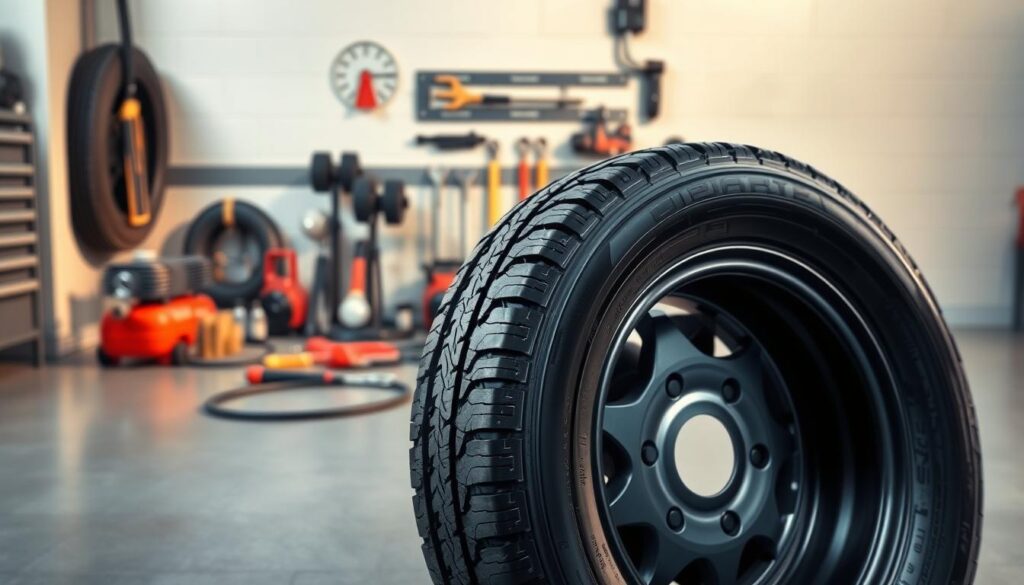
Keeping your spare tire in good shape is key. Many drivers forget about their spare, thinking it will always be ready. But, regular care can make a big difference. It keeps your spare tire in top shape for when you really need it.
Here are some important steps to follow:
- Check tire pressure monthly
- Inspect for visible damage or wear
- Store in a cool, dry location
- Rotate location periodically
- Protect from direct sunlight
Tire rubber naturally gets worse over time, even if you don’t use it. Most spare tires stay good for 6-10 years. After that, the rubber starts to break down, affecting how well it works.
Things like temperature changes, humidity, and sunlight can also harm your spare tire. Experts say to check your tire every two years. This helps spot any wear and when it might need to be replaced.
It’s smart to keep track of your spare tire’s age and condition. By doing so, you avoid unexpected problems. This ensures your safety and reliability when you need to change a tire in an emergency.
Common Mistakes When Using Spare Tires
Drivers often make big mistakes with spare tires. These errors can put their safety and car’s performance at risk. Knowing how long you can drive on a spare and the rules for using it are key to avoiding dangers on the road.
Managing spare tires well is important. Many drivers miss out on key details that can affect their safety.
Pressure Monitoring Errors
Tire pressure is vital for safe driving with a spare tire. Many forget to check the spare’s air pressure. This can lead to unsafe driving conditions.
Under-inflated spare tires can cause:
- Reduced vehicle stability
- Increased risk of tire failure
- Potential damage to the wheel rim
- Compromised handling and braking performance
Usage Beyond Recommended Limits
Using a spare tire for too long or at high speeds is very risky. Temporary spare tires are not made for long trips or fast driving. Drivers need to know the limits:
- Typical speed limit: 50 miles per hour
- Maximum recommended distance: 50-70 miles
- Avoid prolonged highway driving
- Replace with a full-size tire as soon as possible
Knowing these rules can save you from expensive fixes and safety issues. Always check your car’s manual for advice on using and replacing spare tires.
Legal Requirements and Insurance Implications

Using a spare tire comes with legal and insurance rules to follow. Drivers need to know the rules about how long and how far they can drive on a spare. This keeps everyone safe and legal.
Every state has its own rules for spare tires. These rules cover three main points:
- How far you can drive on a spare tire
- How fast you can go with a temporary spare
- When you need to replace the spare tire
Insurance companies also have strict rules for spare tires. Driving too far on a spare can hurt your coverage. Most insurers say to replace the spare with a regular tire within 50-70 miles to keep full protection.
Driving on a spare tire can lead to legal and financial problems:
- You might get fined for driving too far on a spare
- Your insurance might not cover you as well
- You could be held responsible for accidents caused by the tire
To avoid legal and financial trouble, replace the tire as soon as you can. Experts say to only use a spare in emergencies and get a full-size tire as soon as it’s safe.
Knowing the legal rules helps drivers make smart choices about spare tires. This ensures safety and follows local laws.
The Impact of Vehicle Weight on Spare Tire Usage
Knowing how vehicle weight impacts spare tire use is key for safe driving. The distance you can travel on a spare tire changes based on your vehicle’s weight and capacity. It’s important to remember that not all spare tires are the same for different vehicle types.
Every vehicle has its own needs for spare tire use. A small sedan and a big pickup truck have different rules for spare tires. The spare tire’s performance depends on the vehicle’s weight and how it carries loads.
Load Capacity Considerations
When figuring out how far you can go on a spare tire, think about these important factors:
- Vehicle curb weight
- Passenger count
- Cargo weight
- Trailer or additional equipment
Driving too heavy can cut down the safe distance and performance of a spare tire. Car makers usually set strict weight limits to avoid tire failure or safety issues.
Vehicle-Specific Guidelines
Every car model has its own rules for using a spare tire. Always check your owner’s manual for the right advice. Some things to keep in mind include:
- Recommended maximum speed
- Maximum recommended driving distance
- Specific load restrictions
Drivers should put safety first by knowing their vehicle’s spare tire limits. Not following these rules could harm the tire or make driving unsafe.
When to Replace Your Spare Tire
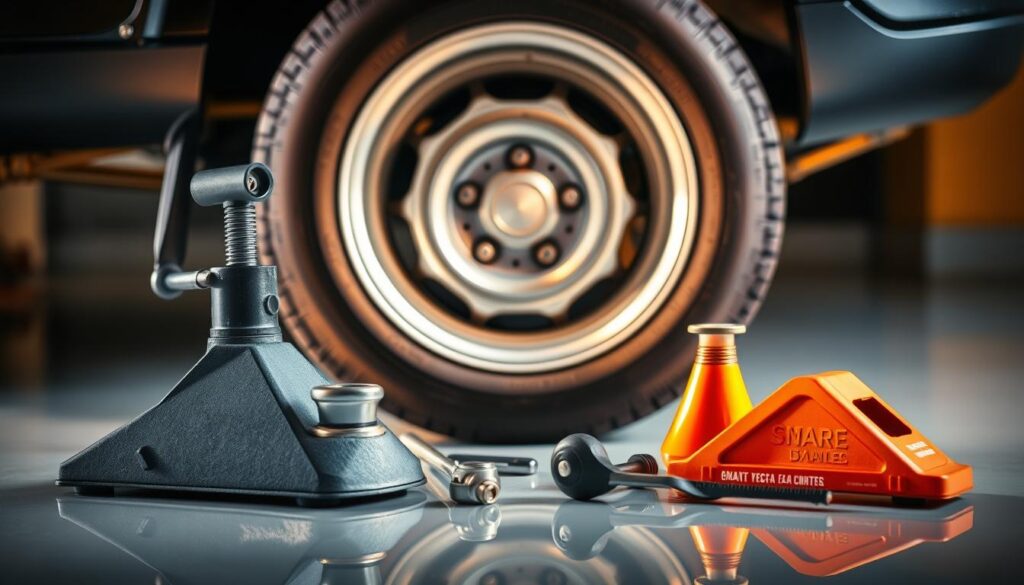
Knowing when to replace your spare tire is key for safety on the road. Even if you don’t use it often, it can wear out. It’s smart to check your spare tire’s condition often to be ready for emergencies.
The life of your spare tire depends on a few important things:
- Storage conditions
- Tire material quality
- Exposure to environmental elements
- Manufacturing date
Car makers say to replace your spare tire every 6-10 years, even if it looks fine. Look for the manufacturing date on the tire’s sidewall to see how old it is.
Signs you need to replace your spare tire right away include:
- Visible cracks or sidewall damage
- Unusual bulges or deformations
- Significant tread wear
- Dry rot or brittle rubber texture
Checking your spare tire before long drives can stop sudden failures. Make sure to check its pressure, tread depth, and overall shape often. This keeps it ready for when you need it.
Cost Comparison: Temporary vs. Permanent Solutions
Choosing the right tire replacement can be tough for car owners. It’s important to know the costs of using a spare tire and how long it lasts. This helps in making smart choices about car care.
Drivers have several options when facing tire emergencies. The main choices are:
- Emergency tire sealants
- Compact temporary spares
- Full-size replacement tires
- Roadside repair services
Emergency Repair Options
Tire sealants are a cheap fix for small punctures. They cost between $5 and $15. They’re good for small holes and give you time to get a proper fix.
Long-term Replacement Considerations
Looking at long-term tire solutions means more than just the upfront cost. You should think about:
- Total replacement expenses
- Tire durability
- Safety implications
- Vehicle-specific requirements
Getting a full-size spare might seem pricey at first. But, it can save money in the long run. The average full-size spare costs between $100 and $300. It can prevent the need for many temporary fixes.
Experts say to consider your driving habits and car type when choosing a spare tire. Each option affects your wallet and safety on the road.
Highway Driving with a Spare Tire

Driving on a spare tire on highways needs extra care. The distance you can drive on a spare is key. Most spares are for short trips, up to 50-70 miles at slow speeds.
Highway driving is tough on spare tires. The fast speeds and long distances can be too much. Experts say to drive no faster than 50 mph to avoid blowouts.
- Maintain speeds under 50 mph
- Limit driving distance to 50-70 miles
- Check tire pressure frequently
- Plan for immediate tire replacement
How long you can drive on a spare tire varies. It depends on the spare type, your car’s weight, and road conditions. Compact temporary spares are not made for long highway trips. They wear out fast and can fail.
Plan your route carefully when using a spare tire. Look for places to get a new tire along the way. Try to avoid long drives and get a full-size tire as soon as you can.
A spare tire is only a temporary fix. Driving on it for too long can be risky. Always see a spare as a quick fix, not a permanent solution.
Weather Conditions and Spare Tire Performance
Driving with a spare tire gets tough when the weather is bad. It’s important to know when not to use a spare in extreme weather. Drivers need to be extra careful.
Weather affects how well a spare tire works in different ways. Wet, snowy, or icy roads make it harder to control the car. It’s even more important to follow the time limit for using a spare in these conditions.
- Rain decreases tire grip and increases stopping distances
- Snow and ice create unpredictable road surfaces
- Extreme temperatures affect tire pressure and performance
Temperature is key for a spare tire’s performance. Cold weather can lower tire pressure, while hot weather can damage the tire. Drivers should check tire pressure often when using a temporary spare.
| Weather Condition | Spare Tire Risk Level | Recommended Action |
|---|---|---|
| Rainy | Moderate | Reduce speed, increase following distance |
| Snowy/Icy | High | Minimize driving, replace spare ASAP |
| Extreme Heat | Moderate to High | Check tire pressure frequently |
When the weather is tough, safety comes first. Reduce your speed, keep a safe distance, and replace the spare with a regular tire as soon as you can. In bad weather, using a spare tire is more restricted.
Emergency Services and Roadside Assistance Options
Dealing with a spare tire can be tough, mainly when you’re not sure how far you can go. Knowing your emergency service options can help you handle unexpected tire situations safely and efficiently.
Drivers have many support choices when facing tire emergencies. It’s key to know how far you can go on a spare tire to make smart decisions about roadside assistance.
Professional Help Guidelines
Professional roadside assistance services offer a lot of help for tire emergencies. They can help you deal with complex tire situations with less stress.
- 24/7 emergency tire replacement services
- Certified technicians with specialized equipment
- Immediate response for critical tire issues
DIY vs. Professional Installation
Some drivers are confident in changing a spare tire themselves. But, professional services offer big advantages:
- Guaranteed proper tire installation
- Safety checks and additional vehicle assessments
- Specialized tools and expertise
When picking a roadside assistance plan, look for one that includes full tire support. Your safety and vehicle protection should always be the primary concern.
Alternative Solutions to Traditional Spare Tires
Modern cars are leaving the old spare tire behind. They’re introducing new ways to handle emergencies. These new solutions help with the life and use of spare tires.
Drivers now have many new options instead of the old spare tires:
- Run-flat tires
- Tire repair kits
- Inflator systems
- Emergency mobility solutions
Run-flat tires are a big step forward. They can keep going even after getting a flat. Drivers can keep driving for about 50-100 miles at slower speeds. This changes how we think about spare tires.
| Alternative Solution | Distance Capability | Speed Limitation |
|---|---|---|
| Run-flat Tires | 50-100 miles | Up to 50 mph |
| Tire Repair Kit | Limited temporary fix | Normal driving conditions |
| Inflator System | Emergency inflation | Short-distance travel |
Tire repair kits and inflator systems are small and light. They save space in the trunk and make the car lighter. These options are great for emergencies without the need for a big spare tire.
Drivers need to think about their driving and car needs when choosing these new options. Knowing what each can do helps make sure you’re ready for emergencies and safe on the road.
Conclusion
Knowing how long you can drive on a spare tire is key for your safety and car’s performance. The life of a spare tire greatly depends on whether it’s temporary or full-size. Temporary spares are meant for short trips, usually up to 50-70 miles at slow speeds.
It’s important to keep your tires in good shape and check your spare regularly. Experts from Michelin and Goodyear say to replace temporary spares within 50-100 miles or as soon as you can. Taking care of your tires can avoid roadside troubles and keep you safe.
Using a spare tire needs careful attention to the car’s manual and driving conditions. Always check tire pressure and look for wear signs. Knowing your car’s spare tire needs can help avoid problems on the road.
Get to know your car’s spare tire system well. Keep emergency tools handy and get professional checks. Good tire care is about keeping your car safe and running well for a long time.
